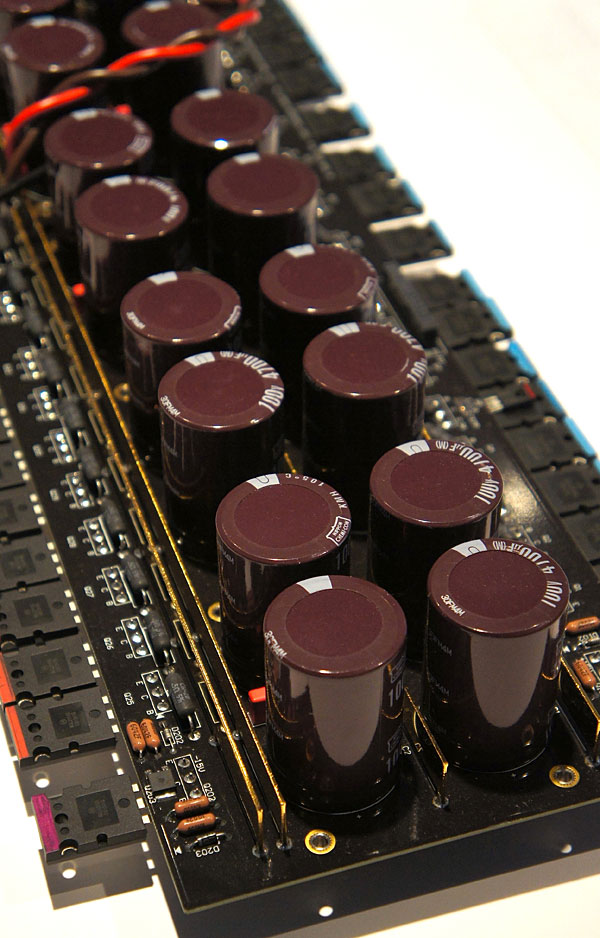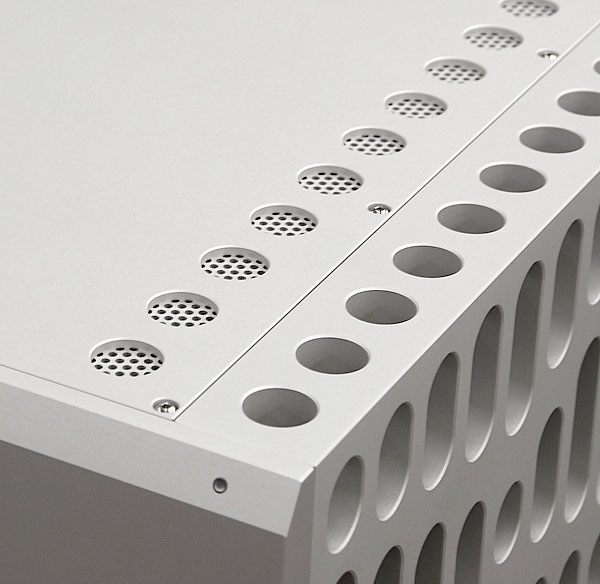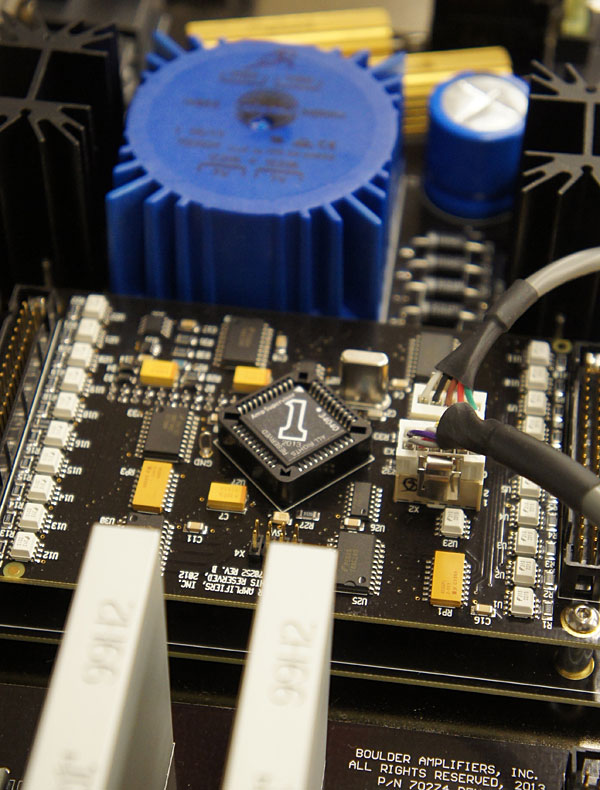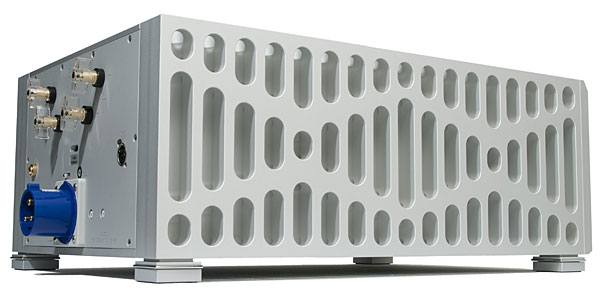| Columns Retired Columns & Blogs |
When do we get to read your comparison of the AudioQuest Hurricane (high-current) and Shunyata Research Zi-Tron Sigma HC?
For example, a recent reissue of Ella Fitzgerald Sings the Cole Porter Songbook (3 LPs, Verve/Analog Sparks 00007), remastered, all in analog, from the original tapes, sounded wonderfully transparent for a 1956 mono recording, but a bit forward through my reference amps—and that was through either my reference Ypsilon VPS-100 phono preamp or the Dan D'Agostino Momentum Phonostage (see this issue's "Analog Corner"), neither of which is bright or ruthlessly revealing. Through the 2150, this album sounded a bit too forward at what I thought was the appropriate volume. Not that Lyra's Etna SL is at all bright, but a cartridge with a more burnished top end would solve that problem.

On the other hand, the Electric Recording Company's vinyl reissue of Leonid Kogan's recording of the Brahms Violin Concerto with Kiril Kondrashin conducting the Philharmonia Orchestra—a 1960 recording—sounded tonally and spatially just right, taking into account the stereo recording techniques of the day.
Another great recording that was reproduced remarkably well by the 2150s is a reissue of Mahler's Symphony 3, with Zubin Mehta conducting the Los Angeles Philharmonic, Los Angeles Master Chorale, California Boys' Choir, and contralto Maureen Forrester, recorded in 1978 in UCLA's Royce Hall (2 LPs, London/Decca/Analogue Productions APC 117). The beginning of the first movement features rumbling timpani that are supposed to represent organic matter bubbling up from primordial ooze. The 2150 didn't clarify the rumbling, which was good, though it did somewhat better define the timpani compared to my reference amps. The big brass climax at the end of the movement didn't harden or lose its pleasingly warm, burnished sound through the 2150s, but compared to my reference amps, it sounded somewhat drier.
However, when I switched to a somewhat more analytical phono preamp that's currently under review, the sound of it and the 2150s leaned too far in the direction of starkness. Were that my reference combination, I'd have to be more in the Koetsu cartridge camp: that's just the way these component recipes work.

The 2150s didn't add grain or grit to the sound, but neither did they hide what's in the recordings, which other electronics might not so clearly reveal. Still, I felt the Boulders' overall sound, while tonally neutral and utterly transparent, was somewhat dry. Can you measure "dry"? Probably not—but you can hear it.
Swapping Boulder's stock power cords for AudioQuest's Hurricanes
The above listening impressions were heard with Boulder's stock power cords. Think power cords can't possibly alter the sound—especially of an amplifier such as the 2150, with its overkill power supply? Sorry, but when I replaced the stock cords with AudioQuest Hurricanes, there was an immediate improvement: The Boulder amp could now better accommodate a wider range of recordings.
While not radically changed, the sound was now less ruthless—like replacing a fluorescent bulb with one of a lower color temperature. Was the AQ cable acting as a filter that actually decreased the 2150's transparency, and thus its performance? I don't know. What I do know is that sonically compromised recordings now sounded more ear-friendly. When I replayed Equinox, it was somewhat less pleasingly immediate, but it didn't exactly recede into the background or become soft. The same held true with the phono preamps mentioned above. The unidentified one, which sounded more analytical, remained so, but even it was now more listenable. I swapped the power cords back and forth more than a few times; the differences remained consistent.
I also swapped out DACs, alternating between the recently reviewed Simaudio Moon Evolution 780D ($15,000) and my reference Lynx HiLo A/D converter ($2500), which also does D/A. (I'd never before used it as a DAC.) While the Simaudio was definitely more highly resolving and closer in sound to the Boulder, the Lynx's easier-going, somewhat more relaxed sound was more inviting when I randomly "swam" in the Meridian Sooloos server, repeating the playlist through both DACs.

Separating the sound of the 2150 from the rest of the system
Listening to any audio product means that you're hearing not only that component but an entire system's worth of audio components. In this case, it was a lot of them, including three different phono preamps, two DACs, and two power cords. Nonetheless, it's possible, through all of that, to hear the sound of the product being reviewed—a good thing, since that's how we do it around here.
The Boulder 2150 is a state-of-the-art powerhouse of an amplifier designed to impart little or none of its own character on the sound of the incoming signal. Boulder has accomplished this by engineering noise to an absolute measurable minimum. The 2150 did likewise with distortion and every other sonic parameter. Its 0 ohm, nonreactive output impedance ensures that its behavior won't vary, regardless of the electrical characteristics of the loudspeaker in use.
In other words, Boulder Amplifiers has done everything it can to achieve the goal of a blank slate: a product that makes the output signal much larger than the input signal, without in any way altering that signal's electrical and, therefore, audible characteristics. I'm confident that John Atkinson's measurements will confirm Boulder's published specs.
Assuming that Boulder has succeeded in all this means that a system's analog and digital source components (as well as the cables that link them) and the speakers that ultimately transduce signals into soundwaves will have the greatest effects on your system's final sound—because these amps will contribute the least. The remaining variable is probably the biggest: the sound quality of the recordings played. With the right associated gear, the best recordings will be allowed to express themselves as well as or better than you've ever heard them. The worst ones won't be able to hide in the shadows, because these amps cast none.

Mobile Fidelity's recent reissue of Santana's Abraxas is made using MoFi's Ultradisc One-Step" process: instead of using plated lacquers to make two more generations of parts, metal negatives made from the lacquers are themselves used as stampers to press discs—in this case, two 45rpm LPs (Columbia/Mobile Fidelity Sound Lab MFSL45UD-1S-001). Played through the Boulder 2150, these discs produced some of the most dazzling recorded sound I've ever experienced. They also sounded really great through my reference amps—but not in the same league.
Conclusions
Based on having the pair of them in my system for an extended period of time, I conclude that Boulder Amplifiers' 2150 is a muscular, tonally neutral, all-controlling monoblock power amplifier capable of unrestricted macrodynamic excursions and, because of its vanishingly low noise floor, the most delicate and highly resolved explorations of microdynamics. The 2150's high level of transparency let me see into the sound as far as is possible, to pick out the smallest details of music and space.
The 2150's electrical stability produced well-controlled, ultra-solid, well-defined low-frequency response that was neither over- nor underdamped, and remarkably clean, precise, etch-free transient response from top to bottom. In fact, the 2150s' overall grip and control produced aural images and a solidity of soundstage that were, in my experience, second to none. The 2150 was "analytical" only in the sense that it added no sound of its own to the signals it was fed—but this means that the associated gear must be chosen with great care. Owners of 2150s must also be willing to accept the fact that some, or even many, of their favorite recordings don't sound so great.

But nothing made by mere mortals is perfect, and every audio product, despite its designers' best intentions, "sounds." I think that the 2150's sound does have an overall character, and that that character is somewhat dry, and lacking the ultimate in musical flow. It reproduced precise attacks and ear-popping decays, but the sustains of notes between those attacks and decays were less than fully expressed.
By comparison, my reference monoblocks, darTZeel's NHB-458s, don't grip quite as tightly as the Boulders, nor do they achieve the 2150s' levels of transparency and solidity. What they deliver so well, especially for solid-state amps, is music's liquidity and natural flow—due to their more generous sustain. You can't have everything.

When do we get to read your comparison of the AudioQuest Hurricane (high-current) and Shunyata Research Zi-Tron Sigma HC?

'"I'm a recording engineer, so I value accuracy," said a panelist in a discussion—titled "How to Read Between the Lines of Audio Advertising"'
Was your response to this statement deliberate trolling or are you really that unfamiliar w/ what recording engineers do? He meant, and I can't believe I have to explain this to you, that what comes out of the amp should be the same as what went in, but amplified. Jeez.
It's like your silly trolling of people (some of whom are also trolling) who say they prefer digital to analog. The correct answer is neither is better than the other, they each do different things well and really it's a matter of which distortions one prefers.
Note, I worked as a recording engineer in the early 90's - classical, jazz, rock, and pop; I did it all.

I've wasted a lot of money in this silly hobby thinking if I moved up to the next level, I'd get better results. Experience and approx. $80k (over the years) I know better... Of course, maybe if I had of pushed up even further to Boulder/etc., I would've finally gotten "there"...

Not sure what this has to do with what I wrote... but if you can't hear the difference between, say, a well designed Class A amp and a well designed class AB or D amp then the problem may simply be that your hearing (or ability to discern fine grain differences in sound) is not up to snuff. Most wine, to me, tastes like grape juice mixed with vodka but I don't doubt that's not the case with most people who actually like wine (I obviously don't), and an experienced wine taster can glean a lot of information from shades of flavor most of us cant discern.
I spent about 5 years where my job was, essentially, to listen carefully (recording engineer). I could hear the distinct differences between two Steinway 9' grands we had my at first job at UT Austin (the Hamburg had more scintillating high harmonics, the NY had fuller low mids) and a Baldwin 9' grand we had (less high end "air" than either Steinway, more pronounced mids than either - no wonder 70's rock bands liked 'em - better at cutting through a mix). I could tell musicians the exact point where they stopped just playing and started thinking about playing (nothing kills feel like thinking about it). Clear differences between different compressors, different EQ's, different reverbs, etc. Audiophiles like to rag on rock/pop recording engineers, but the truth is we pay almost fetishistic attention to the sound but it's the artist and label (the boss) who determine what the final product sounds like (i.e. hard limited, clipped no dynamic range EQ'd to hell and back ear torture of the "loudness wars").
That's something that I like about Stereophile - many of their reviewers have either played or recorded music professionally (or both) so I know they've done a LOT of listening. Also, unlike, say, TAS, they publish measurements of the gear they listen to.

Not worth a response.


“Can you measure "dry"? Probably not—but you can hear it.”
Of course you can measure dryness. It’s the lack of harmonic distortion or reverberation in space to which our ears are continually exposed and become accustomed to. You feel something is missing, and you call that dryness. You can say the same of a music hall which absorb an unusually high level of reflections. We call that “dry” because we don’t hear the multiple layers of sound that we hear otherwise.
Anyway, I just wanted to correct this unfounded belief that you can’t measure everything you can hear. Sean Olive even demonstrated that you can measure “good sound”, despite the very subjective nature of this concept. There is consistency in nature. A very few things are arbitrary, even if you’ll find some aberrant data and some people who have developed a dislike for accuracy (and will advance the hypothesis that it doesn’t even exist).

Mr. A. Hourst, you should be employed by Stereophile as a reviewer.
Reviewers use words like cold, warm, dry, laid-back, etc, etc. No one ever explains what those words mean or in terms describing sound.
I always believe if you can hear sound, you can measure it.

Do you really think everything that can be measured has been discovered? I don't.

What does: warm, cold, dry, analytical, laid back, forward, aggressive all mean.
Are these terms objective or subjective? If a reviewer says and amplifier sounds cold, does that mean the samething as someone saying they feel cold when the temperature drops?

What does: warm, cold, dry, analytical, laid back, forward, aggressive all mean.
Check out J. Gordon Holt's subjective audio glossary at https://www.stereophile.com/reference/50/index.html.
John Atkinson
Editor, Stereophile

I would guess this reader does not drink wine or coffee both of which are described with equally useful descriptors.

He participated in a fraudulent radio show about vinyl vs. CDs.

I still don't believe we can measure everything that can be heard. And I don't buy your definition. Of course you can measure "good sound" versus bad sound but that doesn't mean everything can now be measured, or even that what can be measured is done with complete accuracy. I still believe the human system is superior to what's been devised by man.

I buy and read Stereophile because they publish measurements; I would not buy/read it otherwise. I read the measurements section almost exclusively, since I think that everything else in Stereophile (and especially subjective reviews) has very little value.
But the measurements are worth the price of subscription!

"everything else in Stereophile (and especially subjective reviews) has very little value"
I can't agree more. For example, Mr Fremer, in this review, avoid saying that there exist some "good enough" amplifiers that will sound exactly the same for a fraction of the price. Once you're below a certain threshold of distortion and output impedance, and have enough power, the differences become imperceptible.
Boulder still has a lot of merit for engineering such a stellar measuring amplifier.

I avoided saying what you write because I don't believe it.

Because it's simply not true.

"Once you're below a certain threshold of distortion and output impedance, and have enough power, the differences become imperceptible"
Imperceptible ? to whom? Sir, I have been listening critically to amplifiers driving loudspeakers since 1966. Many of my best friends (even back then) were (and still are) brilliant amp designers. Not one of them, nor I, would make that statement. Have you personally experienced this phenomenon ? Also....Neither they nor I believe a quality amplifer is easy or inexpensive to make.
I am certain MF is one of the most experienced audio listener/observers on the planet, and I personally, place great trust in his observations. (Perhaps we should compare an vintage Hafler DH-500 to this obviously well-engineered Boulder? Do you think you could hear the difference?)

Mr Reichert,
Distortion and frequency response variations (which are typically very low in any well-conceived amplifier), are the only factors that can alter the sound of an amplifier. There’s no dispersion pattern like in loudspeakers, so it’s pretty much a straightforward 2-D signal very simple to measure. All your typical audiophile discourse about “bright” or “dark”, “rich” or “dry”, “musical” or “analytical” is embedded in those two parameters. Each one of them represents either an alteration of the frequency response or the signal integrity. I mean, how else could it be? People who have problems with this assertion invariably fail to 1) measure, 2) match the level within 0.1 dB or 3) listen blind. Usually, they even reach their conclusions based on memory. The problem is you can’t free your mind from its numerous prejudices (a 100 000$ amplifier will surely sound better than a 1000$ one) and aural memory is very fragile, since we tend to listen to something different every time music is played.
I do not question your or your friend’s experience or human qualities. I question the methodology, or lack of, that usually goes into the evaluation of most electronic devices.
And since you make this very personal, no I don’t place Mr Framer as an audio authority.

You're completely ignoring that the amplifier and speaker(s) are a system that interact quite a lot... and a lot of other things. I'm sorry you don't have the ability to hear a lot of these things, maybe spend more time listening - it's a fact that the more time you spend doing something, the more neurons your brain will devote to it. Just as an experienced wine taster can discern shadings of flavor you can't, so can an experienced listener.
There is a lot of sillyness in high end audio (like claiming a power cord coming directly from a wall outlet having an effect on the sound ignores 100 feet of Romex upstream in the wall - assuming both cords are of the same gauge of pure copper wire there won't be a difference) but this isn't one of those things.
Fun story - I once was auditioning a Tandberg preamp (used) to replace my old NAD preamp circa 1990. The sound was significantly different (it sounded like George Massenberg gear - he invented parametric EQ btw) and excellent but I ended up not buying because the RCA jack was poorly designed and the sleeve came off when removing an interconnect. That was just a preamp... if only the build quality had been better I'd have bought it - Tandberg gear was top notch.

Did you match the level to 0.1 dB?
That's a major "difference maker".
Those interactions you're talking about are the result of high output impedance.
My experience is that the sound of electronics is extremely overrated.

good to know that you're just talking out your ass. If you want to know what George Massenburg's equipment sounds like, compare 2 Flim & the BB's albums, anything from DMP (Tom Jung engineered) vs "New Pants" on Warner Bros. If you cannot hear the difference (no level matching required), you are not qualified to comment on audio, at all.

Amp Voltage output capabilty as a function of signal phase change and through changing impedance is measured by other Audio mags. The power cube as the Germans call it, Yes there are "Music" signal loads that test the ability of the amp dealing with the speaker. So your story is a bit shortsighted. It just is not that simple and the amp should be tested with several speakers with different drivers and filters.

Can't even correctly spell my name. I have participated in blind amplifier tests and disproved all of your ridiculous assertions.
However, because my results at an AES of all places (based upon decades of experience) fell outside of the 'average', it was TOSSED.
So guess what? i no longer participate in these wank fests.
But if you believe what you've written, enjoy! Knock yourself out. Say negative things about me too. I could give a shit!

And your comment is idiotic. Every amplifier I've reviewed sounded different. You live within the narrow walls of your foolish comfort zone. Good for you. Mr. Hourst.

Why are you here?

Interesting mention of Boulder's avoiding resonating fins, a legitimate concern if a fine point. That is why one of my amps with large fins has dampers inserted between every fin. Running a hand across the fins before that produced obvious ringing, yes. Even after the dampers they try to a little but I did not want to compromise the cooling too much so I stopped where I did.
Did I hear much difference after the dampers? Not a lot but enough to say that there was an improvement and the cost-free tweak was worth spending a few minutes on and something anyone can take care of themselves. The amp is not overtaxed so it does not run super hot, still, after many years the foam dampers are still in fine shape. It should be noted that that amp was being used on only the woofers in a triamped system so additional harmonics would have been cut off by that factor or I may have heard even more of a change. But that this matters became provably true and Boulder's attention to that detail is appropriate to a product costing that much and admirable.